
|
Sale 36
Pre-Long Beach Coin and Currency Auction
| Flowing/Draped/Bust Half Dollars |
| |
| |
| Lot |
Photo |
Description |
Realized |
Lot 2906 |
 |
1795 Flowing Hair Half Dollar. PCGS graded O-116. VG-10. Two leaves under each wing. Nice blue toning around the edges. Full rims with balanced wear on the devices. A very attractive 1795 flowing hair half dollar. This variety, downgraded from a Rarity 5 rating in recent years, shares the same obverse die with the O-115, but has the 7-9 berry arrangement on the reverse and, even more interestingly, the word UNITED is faintly incused beneath LIBERTY along the upper obverse border (PCGS # 6052) .
Estimated Value $650 - 700.
The Victor Kramer Collection.
View details and enlarged photos
Check results on similar lots
| Realized
$1,438 |
Lot 2907 |
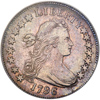 |
1796 Draped Bust Half Dollar. 15 stars. PCGS graded Overton-101. EF-40. Nice original even toning. Very important type coin. An especially clean and attractive example providing the most advantageous order for a collector inasmuch as this is the most important half dollar Type in all of American numismatics. Its high degree of natural "old silver" patina is a definite plus, since there is no evidence of cleaning. Well struck, too, with just a small amount of weakness at the stars which have flat tops. A few very faint hairlines on the shoulder; only faint traces of planchet adjustment along the lower right obverse rim plus in the cloud below the eagle's feet requires magnification to see. The rims are complete, choice, unbroken by nicks.
The draped bust, small eagle halves are among the most mysterious of U.S. coin types, as well as among the rarest. Two obverses dated 1796, respectively with 15 and 16 stars, were muled with a single reverse, which was carried over to make the first of the two varieties dated 1797 -- again with 15 stars, not 16: Why? The mystery deepens when we consider delivery dates described in the last lot. By internal evidence, both 15-star obverses must have been made before June 1796, as the shift to 16 stars commemorated the admission of Tennessee to the Union on June 1. Then the 16-star die must have been completed either anticipating or following the celebrations of that time.
The draped portrait of Liberty is by Robert Scot after a drawing by Gilbert Stuart, modeled by Mrs. William Bingham (nee Ann Willing), Philadelphia socialite reputed to be one of the most beautiful women of her day. John Eckstein is credited with the eagle; the palm branches were originally a compliment to Mint Director DeSaussure's South Carolina homeland, but by the time these half dollars were made, the device was an anachronism, as DeSaussure had long since resigned. Pop 3; 10 finer. (PCGS # 6057) .
Estimated Value $90,000 - 100,000.
View details and enlarged photos
Check results on similar lots
| Unsold |
Lot 2908 |
 |
1796 Draped Bust Half Dollar. 16 stars. PCGS graded MS-64 Overton-102. Well struck with reflective surfaces. Only 1 finer which is graded MS66 in a Texas collection. The finest example we have ever handled in 50 years. PCGS serial number 06135942. The gorgeous Mint State coin offered in this sale is part of the illustrious, and very rare draped bust, small eagle series of early half dollar. This Type consists of only two dates, 1796 and 1797, each of which is represented by two die varieties. The 1796 issue with 15 obverse stars is Overton 101, that with 16 stars is categorized as Overton 102. The 16 stars coin was said to be made after the admission of Tennessee to the Union on June 1, 1796. Tennessee became the 16th state, hence, 16 stars.
Curiously, all 1796 and 1797 half dollars are thought to have been minted in 1797 as part of three deliveries. Mint records show that the first delivery was made on February 28, 1797 (60 coins), the second delivery on March 21 (874 coins), and the final one on May 26 (2,984 coins). Breen (Complete Encyclopedia of U.S. and Colonial Coins), makes the assumption that the February delivery contained those with 15 stars; while the coins minted in March included some 1796 with 15 stars and others with 16 stars. (Later production in May consisted mostly of 1797-dated pieces but may have included the last of the 1796's with 16 stars.)
Fewer than 4,000 small eagle half dollars were struck in 1796 and 1797 combined. Of these, no more than 5% exist in collectors' hands or in museum collection, the vast majority of which show extensive wear, often with retooling or plug-filled holes. This piece compares favorably with the very best survivors, and it is not far removed from the finest 1796 half dollar, the MS-66 graded by PCGS that now resides in a well known collection that may never be sold. A shimmering, pewter-gray to steel toned coin radiating mint prooflike glow on gorgeous almost gem quality silver surfaces. There are some adjustment marks criss-crossing the eagle's breast. Sharp detail on all devices is typical for this issue; however, with present Mint State 64 we see a wonderful crisp strike found on the stars, hair curls, and Liberty's drapery. The eagle, barring the inconstancies of the adjustment lines, shows great depth of detail, as do the supporting branches of the wreath, with laurel represented at the left, and a palm branch on the right. A marvel of preservation! (PCGS # 6058) .
Estimated Value $350,000 - 390,000.
View details and enlarged photos
Check results on similar lots
| Realized
$414,000 |
Lot 2909 |
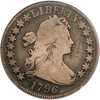 |
1796 Draped Bust Half Dollar. 16 stars. . O-102. NCS graded Sharpness of VG-7 Browning-1. 6 Distant. Obv Scratches. Some old scratches are noted on obv. A pleasing uniform medium violet grey with lighter "rubbed" silver highlights giving the traditional appearance of a coin from circulation. Scarce draped bust, small eagle first year and a one year Type. Only 6,146 pieces were minted from two die pairs. This has the 6 in the date away from the bust and all digits seem to lean slightly to the right.
Estimated Value $15,000 - 17,500.
Purchased from Bowers & Merena 10/02/92 as Fine 12 for $15,850.;The Victor Kramer Collection.
View details and enlarged photos
| Realized
$16,675 |
Lot 2910 |
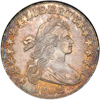 |
1802 Draped Bust Half Dollar. . O-101. NGC graded AU-50. Nicely toned. There is one short mark on the upper part of the shield, and then too, a single equally unimportant nick on the obverse rim by the 11th star, otherwise extremely choice for such an early half dollar. A refreshing toned example of the highest circulated quality usually seen for this scarce date. Full original surfaces like this demand a stretch when bidding. Pop 2; 11 finer.
Estimated Value $9,000 - 11,000.
View details and enlarged photos
| Realized
$13,800 |
Lot 2911 |
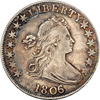 |
1806 Draped Bust Half Dollar. Knobbed 6, large stars. EF-40. Traces of overdate. 0/0 in Date. Breen-4583: 5 berries in wreath. Knob 6, Large Stars. Very rare double-error: 6/5 overdate plus "0" over horizontal "0" in date. Also, on the edge, "C" of CENTS is struck over a star. Choice Extremely Fine, handsome gray surfaces with light golden toning. Found recently in England.
Estimated Value $1,500 - 1,800.
View details and enlarged photos
| Unsold |
Lot 2912 |
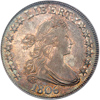 |
1806 Draped Bust Half Dollar. Pointed 6, stem through claw. PCGS graded AU-53 Overton-115a. Extensive die cracks. Old green holder. Nice old time toning. Popular type coin. A splendid warm gold and antique gray specimen with forceful luster around the maind evices, a confident strike, and eye appeal that just won't relinquish your attention! Pop 28. (PCGS # 6071) .
Estimated Value $3,000 - 3,500.
View details and enlarged photos
Check results on similar lots
| Realized
$4,370 |
Lot 2913 |
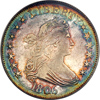 |
1806 Draped Bust Half Dollar. Pointed 6, stem through claw. PCGS graded EF-40. A soft strike with traces of luster still present. Light violet in the centers, iridescent blue to aquamarine at the borders, a heavenly combination that is only now and then present on one of these handsome early draped bust pieces. Well worth consideration. The extensive die break through the bottom of the date and into the stars on the left are characteristic of many half dollars minted in 1806. There must have been stress on the dies at this area, which tended to weaken them before they finally began to crack (PCGS # 6071) .
Estimated Value $800 - 900.
The Victor Kramer Collection.
View details and enlarged photos
Check results on similar lots
| Realized
$1,438 |
Lot 2914 |
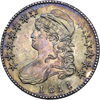 |
1811 Capped Bust Half Dollar. MS-62. Nicely toned with original "old silver" patina, none too heavy, not too light, just right so that it allows the underlying free-flowing luster to shine through. The eagle has a sharp shield and right wing, with plain neck feathers, but only marginal weakness on the left wing and top part of the beak.
Estimated Value $1,000 - 1,200.
View details and enlarged photos
| Realized
$1,150 |
Lot 2915 |
 |
1817/3 Capped Bust Half Dollar. NGC graded Overton-101. EF-40. Attractive iridescent toning about the borders, no doubt from long storage in an old coin ablum, which imparts this sort of beautiful color. The surfaces are lustrous, the overdate boldly featured. Centers are weaker than usual in lacking much of the detail in the hair curls, drapery and clasp. As for the eagle, it too is very flatly struck. Yet ample mint luster attests to this coin having spent only a short while in circulation. Later die state with break through 50 and well beyond up to E of AMERICA.
Estimated Value $500 - 600.
View details and enlarged photos
| Realized
$834 |
Lot 2916 |
 |
1822 Capped Bust Half Dollar. NGC graded MS-62. Dark toning on both sides This conditionally difficult contribution to the Bust half dollar series is lustrous with rich toned surfaces. The strike is weak on both sides, being sharp in a few areas like the stars and legends, but suffering under a low amount of strike pressure in the centers. This is mainly noticeable in Liberty's hair waves and a portion of the eagle's wing and left side. Nevertheless, the fields are choice, uncleaned, and original. Pop 46; 76 finer at NGC.
Estimated Value $850 - 900.
View details and enlarged photos
| Realized
$978 |
Lot 2917 |
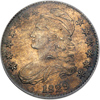 |
1829 Capped Bust Half Dollar. PCGS graded MS-62 PQ. A satiny frosted specimen with a wealth of underlying luster on its well toned, somewhat wood-grained (and attractive) russet and gray surfaces. Nicely struck in all areas with bold hair curls, cap, drapery and clasp on Liberty. A lovely coin. Pop 61; 97 better. (PCGS # 6154) .
Estimated Value $900 - 1,000.
View details and enlarged photos
Check results on similar lots
| Realized
$1,150 |
Lot 2918 |
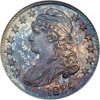 |
1834 Capped Bust Half Dollar. NGC graded Proof 67. Lovely blue and gold toning. Housed in PCGS holder number 1742510002. This incredible coin is so distinctive, and so fantastic that is surpasses by two full points the Proof 65 example in the 1834 King of Siam Proof Set, the most talked-about set of Proof coins in American numismatics! Deep blue toning enfolds itself around the swirling mirror fields and crisp devices and is resplendent throughout. Fully original with a near-perfect strike. Something perhaps worth pausing to study is the fact that all central devices were struck with uncharacteristic crispness and in high relief, with desirable consistency of this year, that is, sharply by the dies, which then left behind bold elements of detail throughout. Only the outer ring of stars shows any weakening, and this in the form of "pulling" towards the edge as the metal of the planchet expanded outwards during the "squeeze" of striking.
The seventh and final stylistic change to Reich's venerable capped bust left Half Dollar is seen in the 1834 to 1836 lettered edge pieces. There had been a massive redesign by the mint, with a smaller, sharper face and a downward-tilted bust line. Stars also are smaller. Most of these modifications were aimed at improving the striking quality of the dies. Only a handful of Proofs were issued for special purposes in 1834. None were offered for sale to the public. A wonderful coin. Pop 1; none finer.
From the Breen encyclopedia of Proofs coinage: "Type I: Large date and stars, large letters. At least two die varieties come in proof, according to Stewart Witham. One of these (Overton 103) is in the King of Siam proof set. Cf. also Bolender-Cass-"Empire":1336; Woodin:206 (1911); Davis?Graves: 528; Philadelphia Estate, ex Mehl 12/12/39 (Overton 101); Lichtenfels I:2785. One of these is possibly ex McCoy: 457, Levick.
"As the large date, stars, letters type was the earliest of the year, it is singular that a specimen of it would have been used for the Siam proof set. Possibly no other types had at that time been struck in proof. Those claimed to exist of Type IIia (small date, large stars, small letters, large C in 50 C.) have proved to be restrikes using an apparently original obverse, altered at border to produce the plain raised rim outside the beading as on 1836 Gobrecht coins, combined with a reverse similarly treated, most like 1836 Ov. 106. (However, the Ov. 106 die cracked up and the cracked die coins have normal borders, so it is a different die.) No specimens have been seen of the other types (II: large date and stars, small letters; IIib: as IIia but small c; IV: head of 1835, small date, stars and letters, bust sloping down much more than formerly)."
Estimated Value $100,000 - 115,000.
View details and enlarged photos
| Unsold |
Lot 2919 |
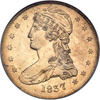 |
1837 Reeded Edge. PCGS graded MS-63. Sharply struck and lightly toned. An very apprecialy array of luster forms nice smooth cartwheels beneath the pale toning. The centers play host to very crisp detail, and only the outer margin at the stars comes up short in terms of boldness. A attractive coin, one that certainly meets the MS63 qualifications for the grade. Pop 73; 74 finer. (PCGS # 6176) .
Estimated Value $1,750 - 2,000.
View details and enlarged photos
Check results on similar lots
| Realized
$2,128 |
Lot 2920 |
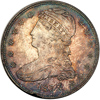 |
1837 Capped Bust Half Dollar. Reeded Edge MS-63. A full strike with frosty luster overlaid with natural mottled violet toning to deep blue at the borders. A gorgeous toned bust half dollar of the optimum, hand-picked order as far as the original toning goes. The nicely lustrous surfaces show signs of mingled medium golden brown to deep shades of iridescence. And only a few light contact marks. Agreeably well struck to say the least, including the stars which for some reason tend to be weak on 1837 halves; the eagle, too, is outstanding in its detail. We note an tiny edge cut just the left of the date, otherwise deserving a point or two higher. Easily worth our conservative estimate.
Estimated Value $1,300 - 1,400.
View details and enlarged photos
| Realized
$1,610 |
Lot 2921 |
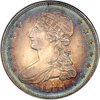 |
1838 Capped Bust Half Dollar. NGC graded MS-61. Lovely blue and golden toning. A few light contact marks on Liberty's chin area. A frosty, satiny toned coin with residual cartwheel luster on both sides. Nicely struck as well, without the usual weakness on the stars. This short-lived Type was introduced in 1836, then modified (to switch from 50 CENTS to HALF DOL.) in 1838, and finally surplanted by the seated Liberty mofif partway into 1839 (PCGS # 6177) .
Estimated Value $1,000 - 1,300.
Ex Jules Reiver Collection.
View details and enlarged photos
Check results on similar lots
| Realized
$1,380 |
Lot 2922 |
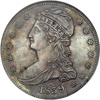 |
1839-O Capped Bust Half Dollar. NGC graded Proof 62. Nice gray toning. A few tiny handling marks. Normal coin alignment (several other Proofs of this issue have the reverse rotated 180 degrees to medallic alignment). Extremely rare. An extremely sharp-looking capped bust half dollar, a coin with superb details in the hair and a wallop from the dies that is amazingly in its completeness, including the stars. Attractive deep "antique silver" colored toning with faint accents of rose, blue and pale green suggests that the present specimen spent much of its life in an old style collector's cabinet or possibly in one of the craft paper coin envelopes seen in Estate collections from the thirties and forties.
This is one of the most illustrious examples known and an important rarity. One of the most important features is also the bold obverse O Mintmark above the date. The obverse mintmark was used for just a couple of years before the mint transferred it to the reverse where it remained until the early 20th century. As we now know, the various branch mintmarks stayed on the reverse until 1909 when the obverse mintmarks appeared on cents and double eagles (1908), and 1916 when they appeared on the obverse again on quarters and half dollars. The reeded edge pieces were first struck in 1836 with FIFTY CENTS spelled out for the denomination. In 1838, the design was modified somewhat and the denomination changed to HALF DOL. Only 20 of the 1838-O pieces were struck (all of them Proofs), but possibly far fewer Proofs were made of the 1839-O, of which this is the first we have ever offered for sale at auction. Designed by Christian Gobrecht; weight 13.36 grams.900 silver.100 copper, diameter 30 millimeters; reeded edge.
According to the Coinsite website, a major source for information about America's early coinage, NGC has graded just three Proof 1839-O Half Dollars: this Proof 62, a Proof 64, and the finest of which is a Proof 65. In addition, NGC has graded a single Specimen 1839-O Half Dollar at the SP-62 level.
The 1839`O' Proof Half Dollars were probably struck during late March and June, 1839. The obverse die used for their production was a new one shipped that year from Philadelphia, but the reverse was one of the two dies shipped in 1838. It is very possible, therefore, that the 1838`O' Proofs and the 1839`O' Proofs were struck during the same short time frame, since the 1838`O' obverses were defaced on June 21, 1839. The 1839`O' Proofs seem to have been struck before the business strikes from the same dies. NGC #1771662-015.
Estimated Value $75,000 - 85,000.
View details and enlarged photos
| Unsold |
|
|